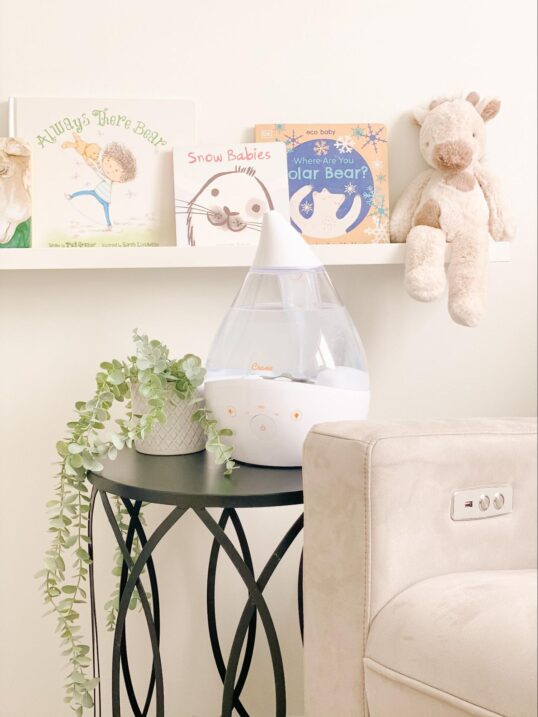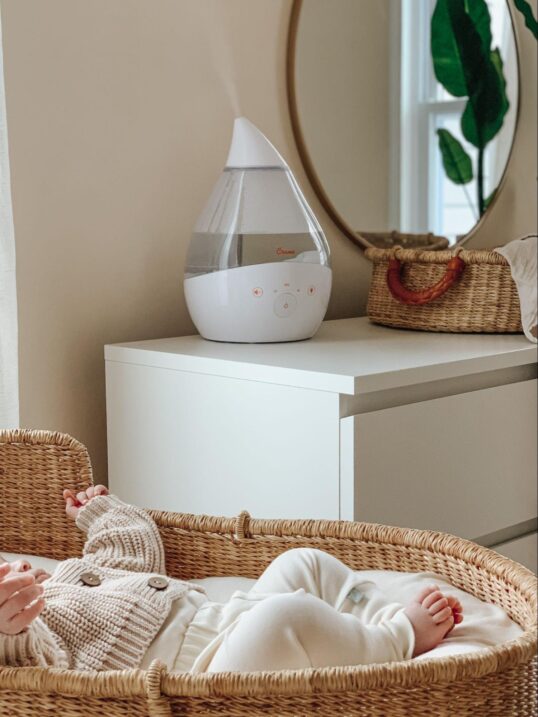When you’re setting up a nursery, a humidifier might not be the first thing on your list, but it probably should be pretty high on it. Why? Well, dry air can cause all kinds of issues for little ones, especially in the winter or if you live somewhere with low humidity. We’re talking dry skin, chapped lips, congestion and those middle-of-the-night coughs that leave everyone wide awake.
So yes, humidifiers can be good for babies. In fact, they can help with infant congestion and overall comfort. But here’s the part a lot of parents aren’t sure about: how do you actually use one safely? And where’s the best place to put a humidifier in a nursery?
Before we get into placement, let’s talk about the ideal humidity for baby sleep, and why it makes such a big difference.

Are Humidifiers Good for Infants? (And When Do They Help Most?)
Let’s get this out of the way first: yes, humidifiers are generally safe (and often really helpful) for infants. As we mentioned, they’re especially useful during cold and dry months, or if you live in a climate where the air tends to feel more like a desert than a nursery. One of the biggest humidifier benefits for infants is helping them breathe easier when they’re stuffy and sick. That moisture in the air can loosen up congestion, soothe dry nasal passages and help everyone get a little more sleep.
Another big plus? It’s gentler on baby’s skin. If you’ve noticed your little one getting flaky patches or chapped lips, dry air might be the culprit. A humidifier can help bring moisture into the nursery and back into their skin.
If you’re shopping around, go with a cool mist humidifier. Most pediatricians recommend that type over warm mist models, which can get too hot and pose a burn risk. The cool mist works just as well for infant congestion, and it’s safer to run all night long in your baby’s room.
What’s the Ideal Humidity for a Baby’s Room?
The ideal humidity for a baby’s room usually falls somewhere between 40% and 60%. That sweet spot helps keep the baby comfortable without creating other issues in the nursery. Too little humidity, and you might start noticing dry skin, scratchy throats or stuffy noses. Too much, and you’re dealing with a whole different problem, like mold or dust mites, which nobody wants anywhere near their newborn.
If you’re not sure where your room stands, a simple hygrometer (you can find them online) will tell you your current newborn humidity level. It’s a small tool that makes a big difference when it comes to knowing whether your humidifier is actually helping or adding too much moisture to the air.
The goal is to keep things balanced, just enough humidity to make breathing easier, soothe irritated skin and help your baby sleep more soundly, without turning the nursery into a mini rainforest.
Where to Put a Humidifier in the Nursery (And Where Not To)
Figuring out where to put a humidifier in the nursery can be surprisingly tricky. It’s not just about finding space, it’s about keeping things safe and making sure the humidifier actually does its job. Here’s what to keep in mind:
Best Practices for Placing a Humidifier in a Nursery:
- Keep it off the floor. A humidifier should sit on a sturdy, flat surface like a dresser or shelf, and not on the carpet where it can tip over or get bumped.
- Stay away from the crib. If you’re wondering how close a humidifier should be to a baby, you need to keep it pretty far from the crib. You want it close enough so they get the benefits of added moisture without blowing mist directly on your little one.
- Aim the mist away from the crib. Let the moisture circulate throughout the room instead of pointing it right at your baby’s face.
- Watch those cords. No loose or dangling cords anywhere near the crib. Make sure they’re completely out of reach now and when the baby starts crawling.
- Place it near dry air sources. If possible, set it up near a vent or heater where the air tends to be driest, which will help balance things out faster.
Still not sure where to place a humidifier in the nursery? Think of it like this: you want it close enough to make a difference, but far enough away to keep the baby safe and comfortable.

How Long Should You Run a Humidifier in a Baby’s Room?
So, how long should you run a humidifier in a bedroom, especially when it’s your baby’s? The short answer: it depends. The long answer? You’ll want to keep an eye on the humidity level in the room and adjust from there. A hygrometer will tell you exactly where things stand. Most experts recommend keeping humidity between 40% and 60%. If you’re in that range, you’re golden.
Many parents choose to run the humidifier during naps and overnight since that’s when babies tend to get the most uncomfortable in dry air. That said, more isn’t always better. Running it 24/7 can make the room too humid, which opens the door to mold, dust mites and other stuff you definitely don’t want in the nursery.
If you notice condensation on the windows or the walls feeling damp, that’s your cue to dial things back. A good routine is turning it on at bedtime, checking your levels in the morning and giving the humidifier a break during the day. Clean it regularly too (at least every few days) to keep things safe and healthy for your little one.
Do All Newborns Need a Humidifier?
Does a newborn need a humidifier? Not always. If the air in your home isn’t too dry and your baby is sleeping and breathing just fine, you might not need to add one to your nursery setup permanently. Every baby, and every home, is different, so there’s no one-size-fits-all answer.
That said, are humidifiers good for newborns in the right situation? Absolutely. If you live somewhere with dry air (especially in winter), or if you’re running the heat all day and night, chances are the air in your baby’s room could use a little extra moisture. And if your newborn is dealing with stuffy noses or congestion, a humidifier can make a big difference in how comfortably they sleep and breathe.
It’s one of those tools that might not be essential for every baby, but when you need it (like when they get sick), you’re really glad you have it.
Using a humidifier can really help to keep your baby more comfortable, especially if the air in your home is dry. Just be sure to place it safely (a few feet from the crib, cords out of reach), keep it clean, and check your room’s humidity levels every so often.
Every baby is different, but if yours is dealing with dry skin or congestion, a humidifier might be just what they need.
Need one that’s nursery-safe and parent-approved? Shop Crane Baby’s humidifier collection to find the perfect fit.